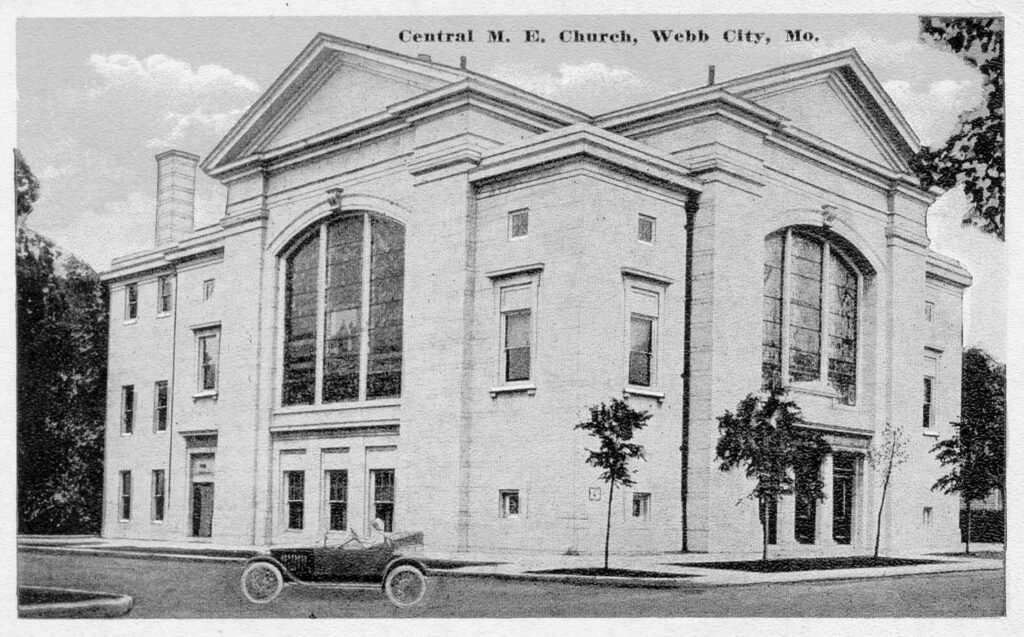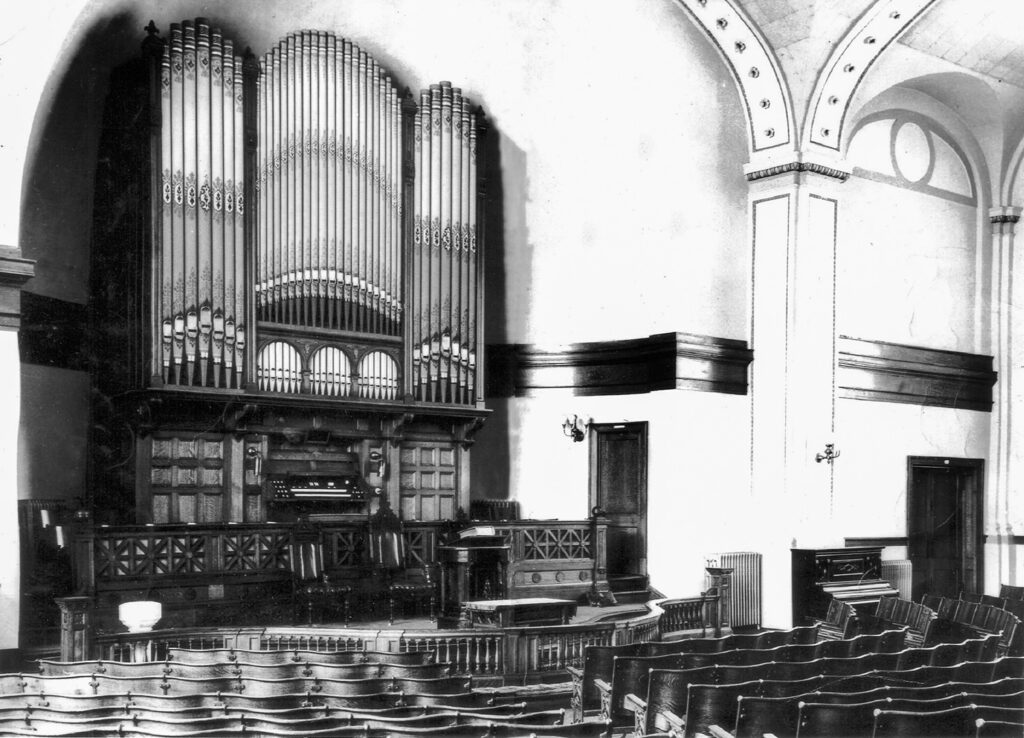
Central United Methodist Church, at the southeast corner of Broadway and Pennsylvania Street, was built on the site of E.T. Webb’s horse barn and was dedicated in 1909. The grandeur of CUMC was the subject of many penny postcards. This colorized card is postmarked 1919.
The pipe organ that stood on the west wall of the sanctuary was removed in 1940 when First Methodist North merged with Central Methodist Episcopal South.

Central United Methodist’s first 100 years
by the Webb City Area Genealogical Society
Sept. 11, 2009, Webb City Sentinel
For one hundred years the Central United Methodist Church has stood with grandeur and grace at the corner of Broadway (once called Joplin Street) and Pennsylvania Street. The church, which is much more than stone and mortar, stairways and beautiful stained glass, is beginning its second century. Over the past 10 decades, generations have gathered there for worship, weddings, christenings, memorials, holidays and fellowship.
First called the Central Methodist Episcopal Church South, it was built during the summer of 1909 and dedicated on Nov. 29, 1909. E.T. Webb, son of Webb City’s founder, tore down his horse barn, west of his house, to provide the land for the church. It was built of Carthage stone at a cost of $60,000-$80,000, depending on which source you read. The interior of the church was finished in Flemish oak with 30 separate rooms, besides the vestibules. The seating capacity was 970, with “opera style” chairs with hat rack and book attachments. The chairs, costing $2,500, were paid for by Mr. and Mrs. C.R. Chinn. The pipe organ was a gift of Ben C. Aylor and his sister, Mrs. S. Nilson, at a cost of $3,500. The church included a living room for the custodian and was proud of its three separate toilets.
The Webb City Standard called the dedication day “an eventful day in the history of Webb City.” Ten days before the dedication, the state convention of the Y.M.C.A. was held in the new church, and the newspaper said that Billy Sunday would be among the noted speakers. He was described in the article as an ex-baseball player and “the greatest evangelist in the United States.”
In 1940, the church would become the Central United Methodist Church. Since the early days of Webb City there had been two Methodist churches in town; one was North and one was South, not in direction, but in their sympathies dating back to the Civil War.
In 1882, John Webb, our city’s founder, donated the land for the first church. It was described as a “Union church” in a city directory. That red brick church stood on the southeast corner of Liberty Street and Broadway. John Webb was not able to attend the dedication services of that 1882 church, so a telephone line was installed at his bedside. He died soon after, having never attended services in the church. Up until that time, Webb City and Joplin had been served by a circuit rider, the Rev. W.C. Campbell
In 1940, the other Methodist church in town, First Methodist Episcopal North, merged with the church. Twenty charter members had formed that church in 1892 under the leadership of the Rev. J.B. Jacobs of New York. The location was really at the edge of town; the corner of Second and Oronogo Streets. At the time, there was only one house standing farther west. After its dedication in June of 1892, the Rev. Jacobs would drown later that summer in North Fork while picnicking with church members.
To accommodate the combined membership in 1940, Central church’s pipe organ was removed. At that time, the direction the congregation faced was changed to the north. The stained glass windows would now be at the front and back of the sanctuary. The opera seats were removed as well, and were replaced by today’s oak pews. While the remodeling was being done, both congregations worshipped together at First Church on Oronogo Street. The First Methodists brought in more than 450 members to join with Central’s 260. The two ministers, Max Barnes and N.A. Goode, would serve as co-pastors for a few months, replaced by one minister the next year, the Rev. Ralph Roland. All in all, 74 ministers have served the Lord and the two congregations of Webb City Methodists.
A 1940 Webb City Sentinel article speaks of how these Methodists had also built a two-story frame building at the northeast corner of Webb Street and Broadway, where later the Sinclair gas station stood. It was said they “climbed a rickety stairway at the back of the church on Sunday mornings.” Their next building was at Third and Webb streets where the First Christian Church is today. They also held street services in a tent. Without a doubt, the church was growing and would need a bigger home. It is said in the CUMC’s 1986 directory that three missions were built to serve the congregations while a “fine new brick and stone building” was erected.
In 1911, two years after the Central church was dedicated, the First Methodists (which is what they called themselves most often) built their new church at the corner of Second and Oronogo Streets. Rev. Dutton, pastor of the First church that year, was said to go often into the local mining fields and mills to visit with “the boys.” He called them his “diamonds in the rough.”
Central Methodist had its own mission church as well. Started in 1910, it was the West Side Mission and was supported by the Central church until it could sustain itself. The West Side Methodist Church closed in February of 1970.
The many buildings, North, South, Central, Episcopal, First, West Side, may make for a complicated church history, but it was always about the Lord’s work.
Pastor D.R. Dorsey and members are now celebrating the 100th anniversary of Central United Methodist Church and welcome all to worship.
Information supplied by CUMC members Marty Blankenship (church historian), Frankie Pyle, Ann Watrous, Lois Spracklen and Marti Pittman.
